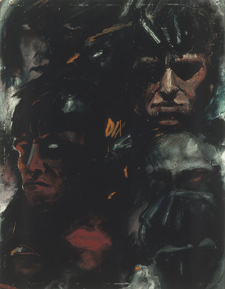Otto Dix self-portrait selected as 2015–2016 KU Common Work of Art
LAWRENCE — In conjunction with KU’s selection of "A Farewell to Arms" by Ernest Hemingway as the 2015–2016 Common Book, the Spencer Museum of Art has selected a self-portrait by German artist Otto Dix from the museum’s collection as the accompanying Common Work of Art. Dix served during World War I, the backdrop of "A Farewell to Arms," and created some of the most incisive and explosive artworks about the war.
 The Spencer’s "Self-portrait," created by Dix in 1914, offers a dark, complex rumination on war, including multiple figures, two of them wearing helmets. An early volunteer for service, Dix served first in a field artillery regiment, becoming a machine gunner and platoon commander by fall 1915 in France, Flanders, Poland and Russia. At war’s end in 1918 he was training as a pilot in Silesia. Dix witnessed some of the most harrowing chapters of World War I and was a survivor of the Battle of the Somme, in which Allied and German forces each suffered more than 600,000 casualties.
The Spencer’s "Self-portrait," created by Dix in 1914, offers a dark, complex rumination on war, including multiple figures, two of them wearing helmets. An early volunteer for service, Dix served first in a field artillery regiment, becoming a machine gunner and platoon commander by fall 1915 in France, Flanders, Poland and Russia. At war’s end in 1918 he was training as a pilot in Silesia. Dix witnessed some of the most harrowing chapters of World War I and was a survivor of the Battle of the Somme, in which Allied and German forces each suffered more than 600,000 casualties.
Celka Straughn, Spencer Museum director of academic programs, said the Dix painting was selected because its complexity opens up many questions relating to WWI, identity and self-representation.
“Students always have lively discussions in the Museum about this work. Our hope is that as the Common Work of Art it will continue to stimulate rich thinking,” Straughn said. “Identifying a work from the Museum’s collection is a great way for students to consider how art connects with ideas in unexpected ways.”
Although the Spencer Museum is currently closed for renovation, the Common Work of Art can be viewed on the Museum’s website, along with other works by Dix and works associated with Ernest Hemingway from the Museum’s collection. The Museum will also collaborate with KU’s Office of First-Year Experience to incorporate the Common Work of Art into Common Book programming.
“Otto Dix’s 'Self-portrait' complements Ernest Hemingway’s 'A Farewell to Arms' by focusing our attention on the human costs of war at the individual level,” said Howard Graham, associate director for academic programs for the Office of First-Year Experience. “Each work, informed by its creator’s personal experience during World War I, illustrates how in war, regardless of the side one occupies, there are no winners.”
Image: Otto Dix, "Self-portrait," 1914, copyright 015 Artists Rights Society (ARS), New York / VG Bild-Kunst, Bonn.